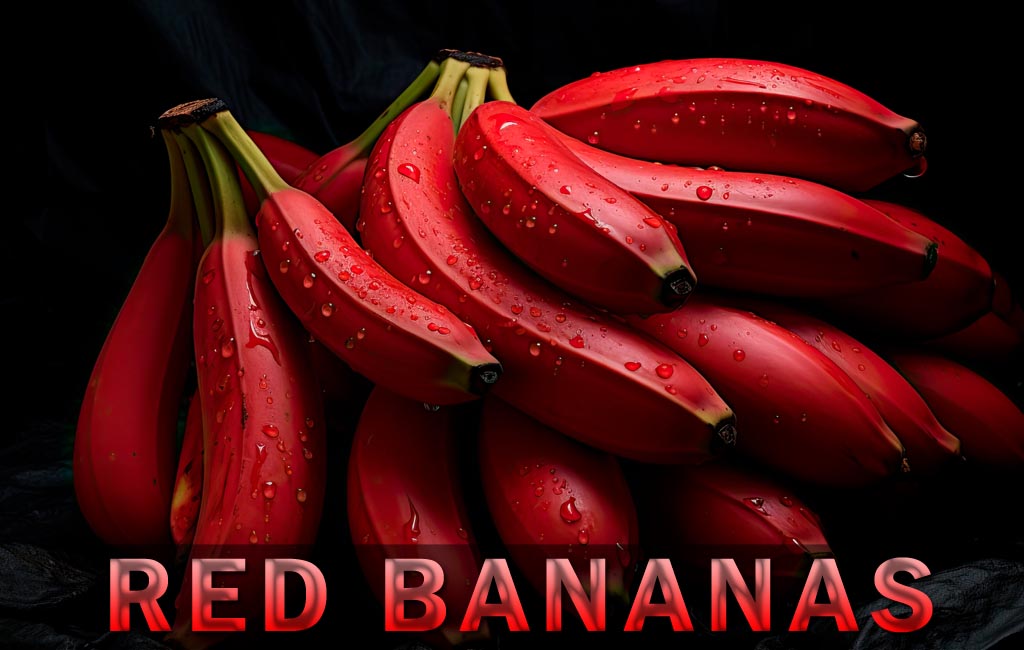Red bananas are a unique and nutrient-rich fruit that is gaining popularity worldwide. Known for their striking reddish-purple skin and sweet, creamy taste, red bananas are more than just visually appealing—they are packed with vitamins, minerals, and antioxidants that can support overall health. In this comprehensive guide, we explore everything you need to know about red banana nutrition, from their origins to their health benefits, nutritional value, ways to eat them, and more.
What Are Red Bananas?
Red bananas (Musa acuminata ‘Red Dacca’) are a variety of banana native to Southeast Asia and Central America. Unlike the familiar yellow Cavendish bananas, red banana nutrition have a reddish-purple skin and a soft, creamy flesh. They are smaller, plumper, and sweeter than yellow bananas and have a subtle raspberry-like flavor.
Physical Characteristics
- Color: Deep red to purplish-red peel
- Size: Typically 5–7 inches long
- Texture: Soft, creamy, and dense
- Flavor: Sweet with a slight raspberry or berry-like taste
Origin and History
Red bananas are believed to have originated in Southeast Asia, particularly Indonesia, and have been cultivated in parts of Central America, Africa, and South America. They were introduced to the United States and other Western countries as exotic fruits, often sold in specialty markets.
Nutritional Value of Red Bananas
Red bananas are packed with essential nutrients that support health and wellbeing. Here’s a breakdown of their nutritional content per 100 grams:
| Nutrient | Amount per 100g | Health Benefits |
|---|---|---|
| Calories | 90–110 kcal | Provides energy and supports daily activity |
| Carbohydrates | 23–26 g | Main source of energy for the body |
| Dietary Fiber | 2–3 g | Supports digestion and prevents constipation |
| Vitamin C | 10–12 mg | Boosts immunity and promotes skin health |
| Vitamin A | 200–250 IU | Supports eye health and immune function |
| Potassium | 400–450 mg | Maintains heart and muscle health |
| Magnesium | 30–35 mg | Supports bone health and metabolism |
| Iron | 0.3–0.5 mg | Supports red blood cell formation |
| Antioxidants | Varies | Reduces oxidative stress and inflammation |
Health Benefits of Red Bananas
Red bananas are a superfood that provides numerous health benefits:
1. Digestive Health
Red bananas are rich in dietary fiber, which aids in digestion, prevents constipation, and promotes a healthy gut microbiome. The fiber content also helps regulate bowel movements and reduces bloating.
2. Heart Health
Potassium and magnesium in red banana nutrition help maintain healthy blood pressure and support heart function. Regular consumption may reduce the risk of hypertension and cardiovascular diseases.
3. Eye Health
Red bananas contain vitamin A and beta-carotene, which are essential for eye health. These nutrients improve vision and may reduce the risk of age-related macular degeneration.
4. Immune Support
High levels of vitamin C and antioxidants in red banana nutrition strengthen the immune system, helping the body fight infections and inflammation.
5. Energy Boost
The natural sugars in red bananas—fructose, glucose, and sucrose—provide a quick and sustained energy boost, making them a great pre-workout snack.
6. Weight Management
Red bananas are low in calories but rich in fiber, which promotes satiety and reduces overall calorie intake, supporting weight management and healthy eating habits.
Pros and Cons of Red Bananas
| Pros | Cons |
|---|---|
|
|
How to Choose and Store Red Bananas
Choosing Red Bananas
- Look for deep red or purplish-red skin without blemishes.
- Fruits should be slightly soft to the touch but not mushy.
- Avoid bananas with large black spots or overly dry skin.
Storing Red Bananas
- Store at room temperature until ripe.
- Once ripe, refrigerate to extend shelf life (skin may darken but flesh remains soft).
- Do not store near ethylene-producing fruits to avoid over-ripening.
Ways to Eat Red Bananas
Red bananas are versatile and can be consumed in multiple ways:
1. Raw Consumption
Peel and eat raw as a snack or add to fruit salads.
2. Smoothies and Shakes
Blend red bananas with milk, yogurt, or plant-based alternatives for a nutritious smoothie or shake.
3. Baking and Desserts
Red bananas can be used in muffins, cakes, bread, and puddings, adding natural sweetness and moisture.
4. Cooking
They can also be lightly sautéed, grilled, or used in tropical dishes to add flavor and texture.
Red Bananas vs Yellow Bananas
| Feature | Red Bananas | Yellow Bananas |
|---|---|---|
| Color | Red to purplish-red | Bright yellow |
| Size | Shorter and plumper | Longer and thinner |
| Flavor | Sweet with slight raspberry taste | Sweet and mild |
| Vitamin A | Higher | Lower |
| Potassium | Comparable | Comparable |
| Antioxidants | Higher | Moderate |
| Best Use | Raw, smoothies, desserts, baking | Raw, smoothies, desserts, snacks |
Potential Side Effects or Considerations
While red banana recipes are safe for most people, consider the following:
- High sugar content may affect blood sugar levels in diabetics if consumed excessively.
- Allergic reactions are rare but possible.
- Excessive consumption may cause mild digestive discomfort due to fiber.
Fun Facts About Red Bananas
- Red bananas are often called “Cuban Red” or “Red Dacca” in different regions.
- They are richer in beta-carotene than yellow bananas, giving them their reddish color.
- Red bananas are popular in tropical regions like India, Indonesia, and Central America.
- The fruit is a symbol of prosperity and good health in some cultures.
- Despite their exotic appearance,red banana recipes are easy to incorporate into everyday meals.
Recipes with Red Bananas
1. Red Banana Smoothie
Blend 2 red bananas, 1 cup milk or almond milk, 1 tablespoon honey, and ice for a refreshing smoothie.
2. Red Banana Bread
Mash 3 ripe red bananas, mix with flour, eggs, sugar, and baking powder, then bake for a moist, flavorful bread.
3. Red Banana Pancakes
Add mashed red bananas to pancake batter for natural sweetness and a hint of fruity flavor.
4. Tropical Red Banana Salad
Mix sliced red bananas, pineapple, mango, and a drizzle of lime juice for a colorful and healthy fruit salad.
Conclusion
Red bananas are a truly remarkable and nutrient-dense fruit, celebrated not only for their striking reddish-purple skin but also for their impressive health benefits and versatile uses. Packed with essential vitamins, minerals, and antioxidants, redbananas provide a natural boost to overall well-being. Regular consumption of redbananas can support healthy digestion due to their high dietary fiber content, help maintain optimal heart function through their rich potassium and magnesium levels, and enhance immune system performance thanks to their vitamin C and antioxidant properties.
In addition to their health-promoting qualities, redbananas are also an excellent source of natural energy. The combination of natural sugars and complex carbohydrates makes them an ideal snack for a quick energy boost or as a complement to a balanced meal. Their creamy texture and subtly sweet, berry-like flavor make them a delightful addition to a wide variety of dishes. From being enjoyed raw as a simple snack to being blended into smoothies, incorporated into baked goods like muffins and banana bread, or cooked in tropical recipes, redbananas provide both taste and nutrition in one convenient package.
Furthermore, red banana recipes are not only beneficial for adults but also suitable for children, athletes, and individuals seeking healthy dietary options. They offer a natural, wholesome alternative to processed snacks, helping to manage appetite and support healthy weight maintenance. With their vibrant color and rich nutrient profile, redbananas also make meals visually appealing while delivering important health benefits.
In conclusion, incorporating red bananas into your daily diet is a delicious and practical way to boost your overall health. Whether you enjoy them fresh, in smoothies, baked treats, or savory dishes, red banana recipes combine flavor, nutrition, and versatility, making them an indispensable part of a health-conscious lifestyle. Embrace this exotic fruit and take full advantage of the numerous wellness benefits that red bananas have to offer.
Frequently Asked Questions About Red Bananas
What are red bananas?
Red bananas are a type of banana with reddish-purple skin and sweet, creamy flesh. They are smaller and plumper than yellow bananas and are rich in vitamins, minerals, and antioxidants.
How do red bananas differ from yellow bananas?
Red bananas have a unique flavor, often described as slightly raspberry-like, and contain more vitamin A and antioxidants compared to yellow bananas. Their texture is also creamier and denser.
What are the health benefits of red bananas?
Red bananas support digestive health, heart function, and eye health. They are high in fiber, potassium, vitamin C, and antioxidants, making them a nutritious addition to a balanced diet.
How should I store red bananas?
Store red bananas at room temperature until ripe. Once ripe, you can refrigerate them to extend shelf life. Keep in mind that the skin may darken in the fridge, but the fruit inside remains fresh.
Can red bananas help with weight management?
Yes, red bananas are low in calories but high in fiber, which promotes a feeling of fullness and helps control appetite, making them useful for weight management.
Are red bananas safe for diabetics?
Red bananas contain natural sugars, so diabetics should consume them in moderation. Pairing them with protein or healthy fats can help regulate blood sugar levels.
How can I eat red bananas?
red banana recipes can be eaten raw, blended into smoothies, baked into desserts, or lightly cooked in various dishes. Their natural sweetness makes them versatile in both sweet and savory recipes.
Do red bananas contain more nutrients than yellow bananas?
Redbananas are richer in vitamin A, beta-carotene, and antioxidants than yellow bananas. They also provide similar levels of potassium and fiber, making them highly nutritious.
Where can I buy red bananas?
Red bananas are available in specialty grocery stores, organic markets, and some supermarkets. They may also be found at farmers’ markets in regions where they are locally grown.
Can red bananas improve digestion?
Yes, the high fiber content in red bananas supports digestive health, prevents constipation, and helps maintain a healthy gut microbiome.
What is the best way to select ripe redbananas?
Choose red bananas with deep reddish-purple skin that are slightly soft to the touch. Avoid fruits with large black spots or overly dry skin for the best flavor and texture.
Are redbananas good for heart health?
Absolutely. Red bananas are rich in potassium and magnesium, which help maintain healthy blood pressure and support overall cardiovascular function.
Can children eat red bananas?
Yes, red bananas are safe and healthy for children. They provide natural energy, vitamins, and minerals essential for growth and development.
Do redbananas contain antioxidants?
Yes, red bananas are rich in antioxidants, which help fight free radicals, reduce oxidative stress, and support overall health and immunity.
How can I use redbananas in recipes?
Redbananas can be added to smoothies, baked goods, pancakes, fruit salads, and desserts. Their natural sweetness enhances flavor and reduces the need for added sugars.



